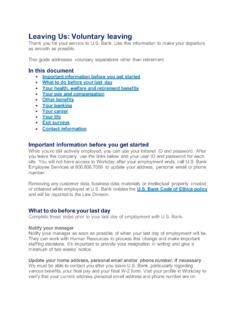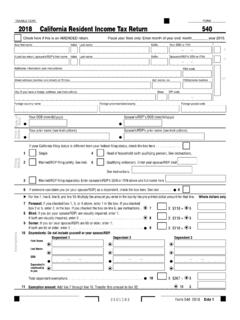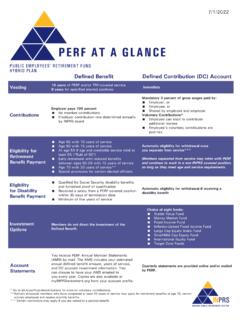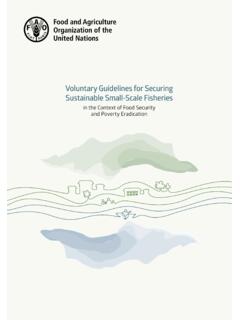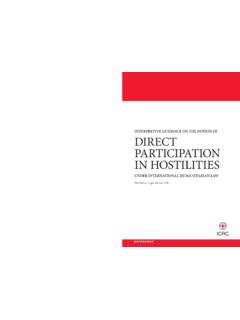Transcription of Chapter 14 The Role of the Voluntary Sector
1 Last updated:October 2011 Civil Contingencies Act Enhancement Programme October 2011V3: Last updated 09/12/2010 PAGE 1 Chapter 14 The Role of the Voluntary SectorRevision to Emergency Preparedness PAGE 2 Emergency Preparedness | The Role of the Voluntary SectorLast updated:October 2011 Summary The Voluntary Sector has an important role to play in supporting the statutory services in the planning, response and recovery phases of most emergencies (paragraph ).Category 1 responders who include the Voluntary Sector in their local planning arrangements will make the overall response more accessible and effective throughout the community.
2 This is not just good practice: the Regulations require Category 1 responders to have regard to the contribution of the Voluntary Sector . This includes considering how the Voluntary Sector can be involved at every stage, including training and exercising to respond to emergencies (paragraphs ).There are four models suggested for Category 1 responders to follow when engaging the Voluntary Sector effectively in order to discharge their duties at the local level (paragraphs ).Responders should be aware of the extent and range of services the Voluntary Sector can offer before making plans to involve them (paragraphs ).
3 It is essential that volunteers from the Voluntary Sector are trained and that they are supported by the responding organisations they are helping (paragraphs ).The way Category 1 and 2 responders work with the Voluntary Sector at the local level is supported by consistent arrangements at other levels (paragraphs ). Chapter 14 (The Role of the Voluntary Sector ) of Emergency Preparedness, Revised Version PAGE 3 Emergency Preparedness | The Role of the Voluntary SectorLast updated:October 2011 WHAT THE ACT AND THE REGULATIONS REQUIREIn some circumstances, emergencies can overstretch the resources of the emergency services, local authorities and other local responders during the response and recovery phases of an emergency.
4 The value of involving the Voluntary Sector at every stage in order to provide additional support has been demonstrated on many occasions. The delivery of their services, and their role as a link between communities and Category 1 responders, may also enable them to support the development of community resilience activities. The Voluntary Sector in the United Kingdom is very large and diverse. The skills and expertise available from the Voluntary Sector vary from place to place. Experience shows that advance planning enables Voluntary Sector activity to be more integrated and effective.
5 The Regulations require Category 1 responders to have regard to the activities of certain Voluntary organisations in the course of carrying out their emergency and business continuity planning duties. Category 1 responders must have regard to those Voluntary Sector bodies which carry out activities in the geographical area for which the responder is responsible. Further explanation of the term have regard to can be found in paragraphs and Sector organisations are those bodies whose activities are carried out not for profit and which are not public authorities or local authorities.
6 Under the Regulations, they become relevant Voluntary organisations if they carry on any activities for the purpose of preventing emergencies, reducing, controlling or mitigating the effects of emergencies, or taking other action in connection with emergencies. This is a broad definition that will capture charities and other Voluntary 23(1)Details of the devolved areas and England can be found in Chapter 2 23(2)123 PAGE 4 Emergency Preparedness | The Role of the Voluntary SectorLast updated:October does not mean that Category 1 responders should work only with those Voluntary Sector organisations established solely for the purpose of working in the field of civil protection.
7 Few Voluntary Sector bodies are established for the sole purpose of responding to emergencies. Most will have a partial interest tangential to their main business, for example, this may include faith organisations. Nevertheless, these Voluntary Sector organisations must be factored into local civil protection arrangements where they may have a contribution to make or a role to play in planning for, or responding to, or recovery from, an emergency. This obligation is intended to ensure that Category 1 responders actively consider and engage the Voluntary Sector during the planning process, rather than at the end or not at all.
8 As such, simply sending copies of plans to Voluntary organisations is not sufficient, nor is including Voluntary organisations in plans without consulting them. Instead, Category 1 responders must consider and discuss with relevant Voluntary organisations, the capabilities that those organisations within their area have to offer, and whether those capabilities should be built into response and recovery plans. Agreements reached should be captured in plans and signed off by all affected parties. The requirement to have regard to the activities of relevant Voluntary Sector organisations covers both emergency plans and business continuity plans (BCPs).
9 In the case of the former, Voluntary Sector capabilities such as search and rescue or humanitarian support may be built into the response arrangements agreed between the statutory services. In the case of the latter, the Voluntary Sector may, in the course of everyday business, already deliver certain services on behalf of a statutory provider that would need to be maintained (such as meals on wheels ). In addition, certain BCPs may use Voluntary organisations to backfill functions that would be undermined by the diversion of resources to deal with the direct consequences of an emergency or major incident.
10 For example, with PAGE 5 Emergency Preparedness | The Role of the Voluntary SectorLast updated:October diverted to the scene of a large emergency, an ambulance trust might have an agreement with the local St John Ambulance (paragraph ) for the organisation to carry out routine patient collection. However, responders should be aware that the Voluntary Sector may need more support during a sustained response. This should be considered when planning for longer term responses such as swine flu. The Act also requires local authorities to provide business continuity advice to those Voluntary Sector bodies which it considers to be appropriate.











